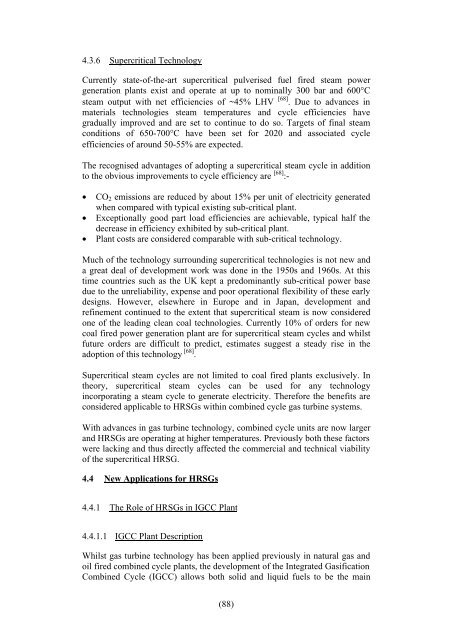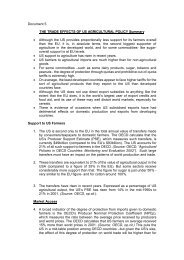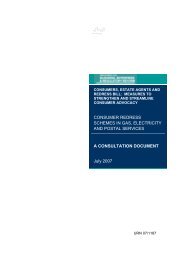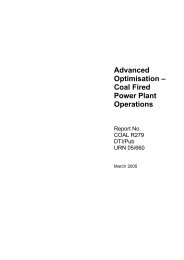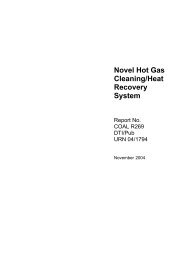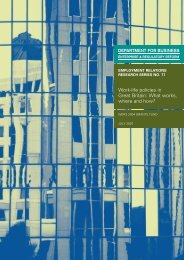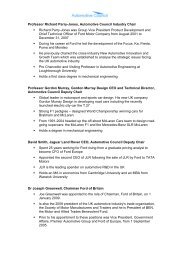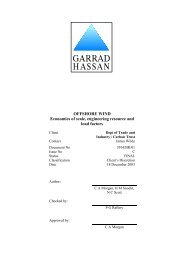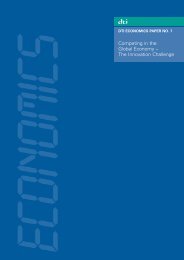(70) Therefore, the risk of sulphuric acid dew point attack ... - DTI Home
(70) Therefore, the risk of sulphuric acid dew point attack ... - DTI Home
(70) Therefore, the risk of sulphuric acid dew point attack ... - DTI Home
You also want an ePaper? Increase the reach of your titles
YUMPU automatically turns print PDFs into web optimized ePapers that Google loves.
4.3.6 Supercritical Technology<br />
Currently state-<strong>of</strong>-<strong>the</strong>-art supercritical pulverised fuel fired steam power<br />
generation plants exist and operate at up to nominally 300 bar and 600°C<br />
steam output with net efficiencies <strong>of</strong> ~45% LHV [68] . Due to advances in<br />
materials technologies steam temperatures and cycle efficiencies have<br />
gradually improved and are set to continue to do so. Targets <strong>of</strong> final steam<br />
conditions <strong>of</strong> 650-<strong>70</strong>0°C have been set for 2020 and associated cycle<br />
efficiencies <strong>of</strong> around 50-55% are expected.<br />
The recognised advantages <strong>of</strong> adopting a supercritical steam cycle in addition<br />
to <strong>the</strong> obvious improvements to cycle efficiency are [68] :-<br />
• CO2 emissions are reduced by about 15% per unit <strong>of</strong> electricity generated<br />
when compared with typical existing sub-critical plant.<br />
• Exceptionally good part load efficiencies are achievable, typical half <strong>the</strong><br />
decrease in efficiency exhibited by sub-critical plant.<br />
• Plant costs are considered comparable with sub-critical technology.<br />
Much <strong>of</strong> <strong>the</strong> technology surrounding supercritical technologies is not new and<br />
a great deal <strong>of</strong> development work was done in <strong>the</strong> 1950s and 1960s. At this<br />
time countries such as <strong>the</strong> UK kept a predominantly sub-critical power base<br />
due to <strong>the</strong> unreliability, expense and poor operational flexibility <strong>of</strong> <strong>the</strong>se early<br />
designs. However, elsewhere in Europe and in Japan, development and<br />
refinement continued to <strong>the</strong> extent that supercritical steam is now considered<br />
one <strong>of</strong> <strong>the</strong> leading clean coal technologies. Currently 10% <strong>of</strong> orders for new<br />
coal fired power generation plant are for supercritical steam cycles and whilst<br />
future orders are difficult to predict, estimates suggest a steady rise in <strong>the</strong><br />
adoption <strong>of</strong> this technology [68] .<br />
Supercritical steam cycles are not limited to coal fired plants exclusively. In<br />
<strong>the</strong>ory, supercritical steam cycles can be used for any technology<br />
incorporating a steam cycle to generate electricity. <strong>Therefore</strong> <strong>the</strong> benefits are<br />
considered applicable to HRSGs within combined cycle gas turbine systems.<br />
With advances in gas turbine technology, combined cycle units are now larger<br />
and HRSGs are operating at higher temperatures. Previously both <strong>the</strong>se factors<br />
were lacking and thus directly affected <strong>the</strong> commercial and technical viability<br />
<strong>of</strong> <strong>the</strong> supercritical HRSG.<br />
4.4 New Applications for HRSGs<br />
4.4.1 The Role <strong>of</strong> HRSGs in IGCC Plant<br />
4.4.1.1 IGCC Plant Description<br />
Whilst gas turbine technology has been applied previously in natural gas and<br />
oil fired combined cycle plants, <strong>the</strong> development <strong>of</strong> <strong>the</strong> Integrated Gasification<br />
Combined Cycle (IGCC) allows both solid and liquid fuels to be <strong>the</strong> main<br />
(88)


